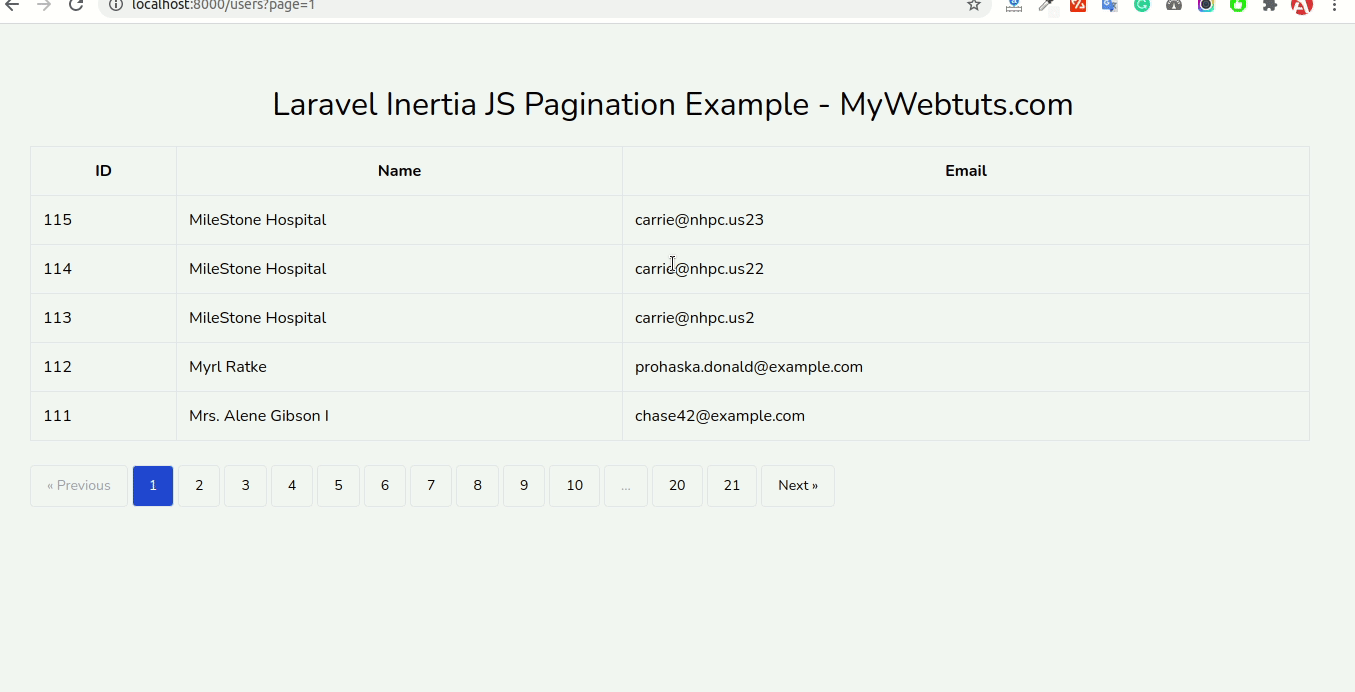Laravel Inertia JS Pagination Tutorial
Apr 30, 2021 . Admin

Hi Guys,
Today, I will learn you how to use inertia js pagination in laravel. We will show example of laravel inertia js pagination.if you want to see example of laravel inertiajs pagination then you are a right place. i explained simply about pagination in laravel inertia js.
We will give you step by step simple example of how to add pagination using laravel inertia js. I will use laravel breeze with inertia to creating this example.
Here, I will give you full example for inertia js pagination using Laravel as bellow.
Step 1 : Install Laravel 8In the first step, we need to get fresh laravel 8 version application So let's open terminal and run bellow command to install fresh laravel project.
composer create-project --prefer-dist laravel/laravel blogStep 2 : Database Configuration
In second step, we will make database Configuration for example database name, username, password etc. So lets open .env file and fill all deatils like as bellow:
.envDB_CONNECTION=mysql DB_HOST=127.0.0.1 DB_PORT=3306 DB_DATABASE=here your database name(blog) DB_USERNAME=here database username(root) DB_PASSWORD=here database password(root)Step 3: Install Laravel Breeze
In this step, let's install laravel breeze with inertia, So open your terminal OR command prompt and run bellow command.
composer require laravel/breeze --dev
After, install breeze with inertia and also run migration using bellow command.
php artisan breeze:install --inertia npm install npm run dev php artisan migrateStep 4: Create Route
In this step, we will create one route for list of all users, add users route here. So, let's add new route on that file.
routes/web.php
<?php
use Illuminate\Foundation\Application;
use Illuminate\Support\Facades\Route;
use Inertia\Inertia;
use App\Http\Controllers\UserController;
/*
|--------------------------------------------------------------------------
| Web Routes
|--------------------------------------------------------------------------
|
| Here is where you can register web routes for your application. These
| routes are loaded by the RouteServiceProvider within a group which
| contains the "web" middleware group. Now create something great!
|
*/
Route::get('/', function () {
return Inertia::render('Welcome', [
'canLogin' => Route::has('login'),
'canRegister' => Route::has('register'),
'laravelVersion' => Application::VERSION,
'phpVersion' => PHP_VERSION,
]);
});
Route::get('/dashboard', function () {
return Inertia::render('Dashboard');
})->middleware(['auth', 'verified'])->name('dashboard');
Route::get('users', [UserController::class, 'index']);
require __DIR__.'/auth.php';
Step 5: Create Controller
Here in this step, now we have create UserController with index methods, in this method we will write code of return inertia view. So let's create controller.
app/Http/Controllers/UserController.php
<?php
namespace App\Http\Controllers;
use Illuminate\Http\Request;
use App\Models\User;
use Inertia\Inertia;
class UserController extends Controller
{
/**
* Write code on Method
*
* @return response()
*/
public function index()
{
$users = User::orderBy('id', 'desc')
->paginate(5);
return Inertia::render('Users', [
'users' => $users
]);
}
}
Step 6: Add Page and Component
Now this step, we need to add pagination component and user vue page. let's add as bellow.
<template>
<layout title="Users">
<div class="container">
<h1>Laravel Inertia JS Pagination Example - MyWebtuts.com</h1>
<table class="table border w-full">
<thead>
<tr>
<th class="border p-3">ID</th>
<th class="border p-3">Name</th>
<th class="border p-3">Email</th>
</tr>
</thead>
<tbody>
<tr v-for="user in users.data" :key="user.id">
<td class="border p-3">{{ user.id }}</td>
<td class="border p-3">{{ user.name }}</td>
<td class="border p-3">{{ user.email }}</td>
</tr>
</tbody>
</table>
<pagination class="mt-6" :links="users.links" />
</div>
</layout>
</template>
<script>
import Pagination from '@/Components/Pagination'
export default {
components: {
Pagination
},
props: {
users: Object,
},
}
</script>
resources/js/Components/Pagination.vue
<template>
<div v-if="links.length > 3">
<div class="flex flex-wrap -mb-1">
<template v-for="(link, k) in links" :key="k">
<div v-if="link.url === null" class="mr-1 mb-1 px-4 py-3 text-sm leading-4 text-gray-400 border rounded" v-html="link.label" />
<inertia-link v-else class="mr-1 mb-1 px-4 py-3 text-sm leading-4 border rounded hover:bg-white focus:border-indigo-500 focus:text-indigo-500" :class="{ 'bg-blue-700 text-white': link.active }" :href="link.url" v-html="link.label" />
</template>
</div>
</div>
</template>
<script>
export default {
props: {
links: Array,
},
}
</script>
now you can simple run bellow command:
npm run dev
Run laravel app with bellow command:
php artisan serveRun bellow URL:
https://localhost:8000/users
It will help you...
